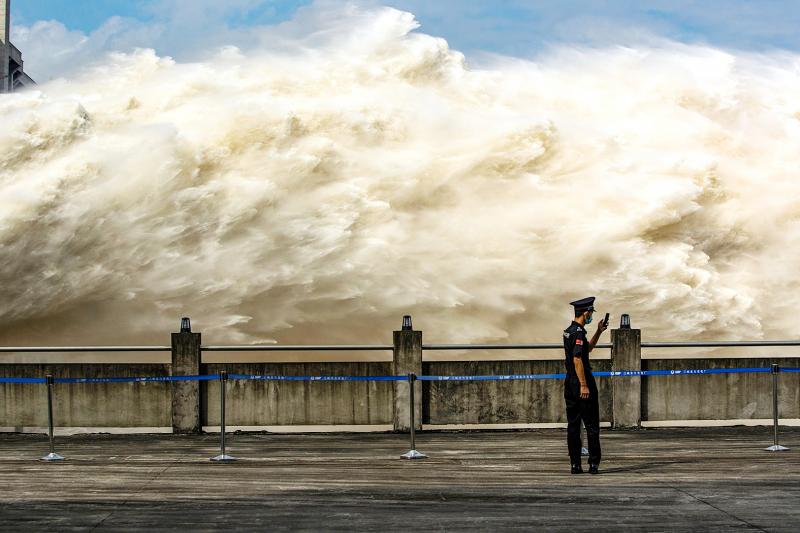Engorged with more heavy rains, China’s mighty Yangtze River is cresting again, bringing fears of further destruction as seasonal floods that have already left more than 140 people dead or missing have grown in force since last month.
The rains are putting renewed pressure on the massive Three Gorges Dam that straddles the river upstream of Wuhan in Hubei Province.
The rate of flow in the reservoir behind the dam would hit a record for the year on Friday night, at 55,000m3 per second, Xinhua News Agency said.

Photo: AFP
The inflow peaked on Saturday at 61,000m3 per second, before easing to 46,000m3 per second by Sunday night, Xinhua later reported.
Rivers in the Yangtze system have broken their banks in places. A helicopter was used to drop stones into a breach to block the inrushing waters in Hubei.
Crews were dispatched with poles to probe waterlogged embankments for weakness and thousands of sandbags were being filled in preparation for more breaches that would need to be swiftly closed.
Water rose to the level of first-floor windows in exposed ancient towns and crops were completely inundated around vast Poyang Lake, a network of waterways that empty into the Yangtze below Wuhan.
On the lake’s eastern edge in Jiangxi Province, 45-year-old Xu Yongxiang said that his village of Liufang had been without running water or electricity for almost a week.
Although it was time for the rice harvest, that crop, along with cotton, corn and beans, was now under water.
“We do not have one inch of dry ground. It has all been flooded,” Xu, who sells pork for a living, was quoted as saying on the China Youth Daily’s microblog.
Flooding since the beginning of the month has forced evacuations of about 1.8 million people in 24 provinces, mainly in southern China. Direct losses attributed to flooding are estimated at more than 49 billion yuan (US$7 billion), the Chinese Ministry of Emergency Management said.
Floodwaters reached as high as 1.4m in Linshui County in Sichuan Province, the ministry’s rescue department reported.
Seasonal flooding strikes large parts of China each year, especially in its central and southern regions, but conditions this year have been especially bad. Major cities have so far been spared, but concerns have risen over Wuhan and other downstream metropolises.

A new online voting system aimed at boosting turnout among the Philippines’ millions of overseas workers ahead of Monday’s mid-term elections has been marked by confusion and fears of disenfranchisement. Thousands of overseas Filipino workers have already cast their ballots in the race dominated by a bitter feud between President Ferdinand Marcos Jr and his impeached vice president, Sara Duterte. While official turnout figures are not yet publicly available, data from the Philippine Commission on Elections (COMELEC) showed that at least 134,000 of the 1.22 million registered overseas voters have signed up for the new online system, which opened on April 13. However,

EUROPEAN FUTURE? Albanian Prime Minister Edi Rama says only he could secure EU membership, but challenges remain in dealing with corruption and a brain drain Albanian Prime Minister Edi Rama seeks to win an unprecedented fourth term, pledging to finally take the country into the EU and turn it into a hot tourist destination with some help from the Trump family. The artist-turned-politician has been pitching Albania as a trendy coastal destination, which has helped to drive up tourism arrivals to a record 11 million last year. US President Donald Trump’s son-in-law, Jared Kushner, also joined in the rush, pledging to invest US$1.4 billion to turn a largely deserted island into a luxurious getaway. Rama is expected to win another term after yesterday’s vote. The vote would

ALLIES: Calling Putin his ‘old friend,’ Xi said Beijing stood alongside Russia ‘in the face of the international counter-current of unilateralism and hegemonic bullying’ Chinese President Xi Jinping (習近平) yesterday was in Moscow for a state visit ahead of the Kremlin’s grand Victory Day celebrations, as Ukraine accused Russia’s army of launching air strikes just hours into a supposed truce. More than 20 foreign leaders were in Russia to attend a vast military parade today marking 80 years since the defeat of Nazi Germany in World War II, taking place three years into Russia’s offensive in Ukraine. Putin ordered troops into Ukraine in February 2022 and has marshaled the memory of Soviet victory against Nazi Germany to justify his campaign and rally society behind the offensive,

CONFLICTING REPORTS: Beijing said it was ‘not familiar with the matter’ when asked if Chinese jets were used in the conflict, after Pakistan’s foreign minister said they were The Pakistan Army yesterday said it shot down 25 Indian drones, a day after the worst violence between the nuclear-armed rivals in two decades. Pakistani Prime Minister Shehbaz Sharif vowed to retaliate after India launched deadly missile strikes on Wednesday morning, escalating days of gunfire along their border. At least 45 deaths were reported from both sides following Wednesday’s violence, including children. Pakistan’s military said in a statement yesterday that it had “so far shot down 25 Israeli-made Harop drones” at multiple location across the country. “Last night, India showed another act of aggression by sending drones to multiple locations,” Pakistan military spokesman Ahmed